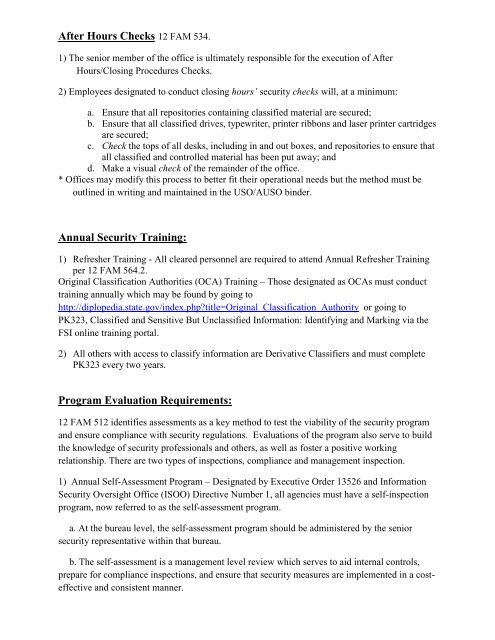PUSO Binder
You also want an ePaper? Increase the reach of your titles
YUMPU automatically turns print PDFs into web optimized ePapers that Google loves.
After Hours Checks 12 FAM 534.<br />
1) The senior member of the office is ultimately responsible for the execution of After<br />
Hours/Closing Procedures Checks.<br />
2) Employees designated to conduct closing hours’ security checks will, at a minimum:<br />
a. Ensure that all repositories containing classified material are secured;<br />
b. Ensure that all classified drives, typewriter, printer ribbons and laser printer cartridges<br />
are secured;<br />
c. Check the tops of all desks, including in and out boxes, and repositories to ensure that<br />
all classified and controlled material has been put away; and<br />
d. Make a visual check of the remainder of the office.<br />
* Offices may modify this process to better fit their operational needs but the method must be<br />
outlined in writing and maintained in the USO/AUSO binder.<br />
Annual Security Training:<br />
1) Refresher Training - All cleared personnel are required to attend Annual Refresher Training<br />
per 12 FAM 564.2.<br />
Original Classification Authorities (OCA) Training – Those designated as OCAs must conduct<br />
training annually which may be found by going to<br />
http://diplopedia.state.gov/index.php?title=Original_Classification_Authority or going to<br />
PK323, Classified and Sensitive But Unclassified Information: Identifying and Marking via the<br />
FSI online training portal.<br />
2) All others with access to classify information are Derivative Classifiers and must complete<br />
PK323 every two years.<br />
Program Evaluation Requirements:<br />
12 FAM 512 identifies assessments as a key method to test the viability of the security program<br />
and ensure compliance with security regulations. Evaluations of the program also serve to build<br />
the knowledge of security professionals and others, as well as foster a positive working<br />
relationship. There are two types of inspections, compliance and management inspection.<br />
1) Annual Self-Assessment Program – Designated by Executive Order 13526 and Information<br />
Security Oversight Office (ISOO) Directive Number 1, all agencies must have a self-inspection<br />
program, now referred to as the self-assessment program.<br />
a. At the bureau level, the self-assessment program should be administered by the senior<br />
security representative within that bureau.<br />
b. The self-assessment is a management level review which serves to aid internal controls,<br />
prepare for compliance inspections, and ensure that security measures are implemented in a costeffective<br />
and consistent manner.


